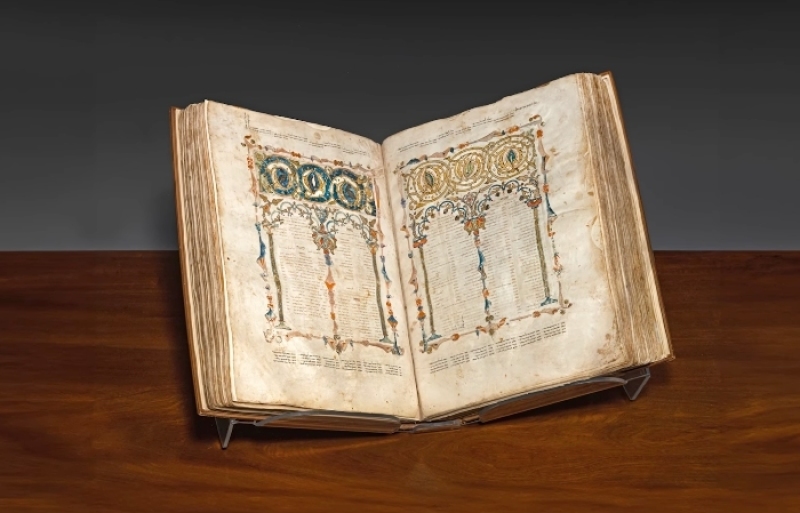
A 14th-century Bible that sold for $6.9 million at auction last year is now on display at the National Library of Israel in Jerusalem.
The Shem Tov Bible, purchased by Terri and Andrew Herenstein in 2024 through Sotheby’s auction house in New York, is being showcased at the National Library of Israel on a long-term loan. Unveiled on May 8, the manuscript is part of the “A Treasury of Words” exhibition in the William Davidson Permanent Exhibition Gallery, as announced by the National Library of Israel.
Chaim Neria, curator of the Haim and Hanna Solomon Judaica Collection at the National Library of Israel, noted that the Shem Tov Bible “represents the pinnacle of biblical and kabbalistic scholarship in the medieval period.” He elaborated that “its addition to the NLI collection provides an unparalleled resource for studying the development of the Masorah, and Jewish textual and artistic traditions, in particular those of Spain.”
“A significant aspect of the codex is its observance of the Sefer Tagei, a traditional guide outlining the scribal practices required for writing sacred texts,” Neria explained. The surrounding notes reference earlier documents, specifically the lost Hilleli Codex of 600 CE. “The Shem Tov Bible thus allows modern scholars to study traditions that have all but vanished from the historical record.”
Rabbi Shem Tov ben Abraham Ibn Gaon completed the Shem Tov Bible in 1312 in Spain. The codex is believed to have remained in the Middle East for centuries before arriving in North Africa in the 17th century, where mystical powers were ascribed to it, such as easing childbirth.
Collector David Solomon Sassoon acquired the manuscript in the 20th century and had it rebound. By 1984, it was purchased by the owners of a prominent European Judaica collection, followed by Swiss collector Jaqui Safra in 1994. The Herensteins acquired it at auction three decades later, eventually bringing the manuscript to the National Library of Israel.
Sallai Meridor, chairman of the National Library of Israel, remarked on the manuscript's significance: “Receiving this manuscript, especially at the time of Shavuot, which celebrates the giving of the Torah, is profoundly significant. Having traveled from Spain to Jerusalem, Baghdad, Tripoli, London, and Geneva, the Shem Tov Bible has come full circle and is now back home, returning to the very place where Rabbi Shem Tov ben Abraham Ibn Gaon lived and intended for it to be, in the land of Israel, and now in Jerusalem.”
As reported by Smithsonian Magazine in August 2024, the Shem Tov Bible’s references to the Hilleli Codex—a famous copy of the Hebrew Bible from the seventh century—make it particularly valuable. The Hilleli Codex served as a model for Hebrew Bibles between the 13th and 15th centuries, although it is now considered lost.


















